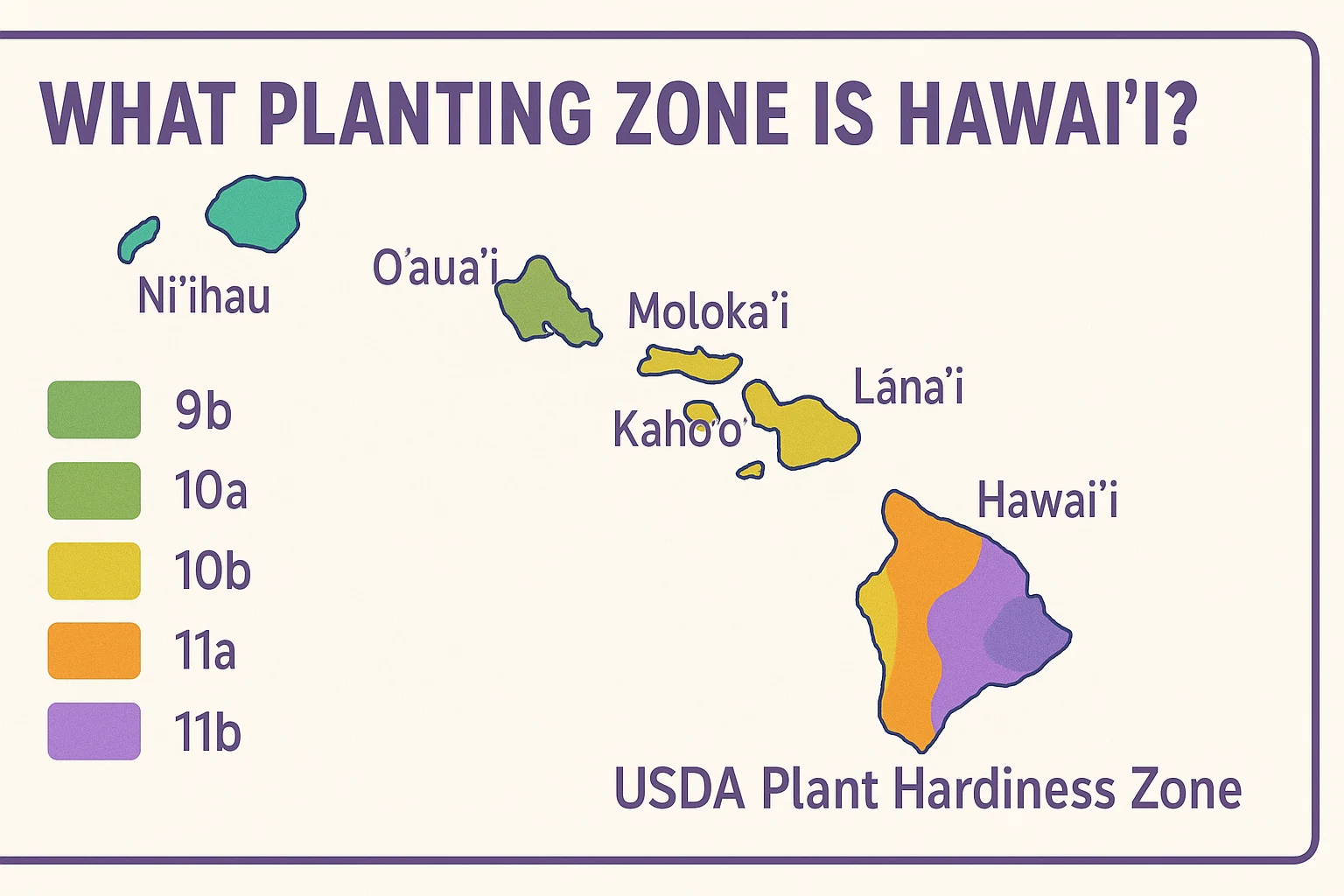What Planting Zone is Hawaii?[Map, Cities, and Growing Tips]

If you’re planning to grow anything in Hawaii — whether it’s tropical fruits, flowers, or vegetables — the first thing you need to know is what planting zone is Hawaii. Understanding your USDA Plant Hardiness Zone helps you choose plants that thrive in Hawaii’s unique climate and avoid wasting time (and money) on varieties that won’t survive.
In this guide, we’ll explain exactly what planting zone Hawaii falls into, how it affects your gardening choices, and tips for growing successfully in the islands’ diverse microclimates.
What Planting Zone is Hawaii?
Officially, Hawaii falls into USDA Planting Zones 9 through 13, which is unlike most of the mainland United States.
| Region | USDA Zone |
|---|---|
| Higher Elevations (Mauna Kea, Haleakalā) | Zone 9–10 |
| Lower Elevations & Coastal Areas | Zone 11–12 |
| Warmest Spots (leeward sides, tropical valleys) | Zone 13 |
This means that depending on where you are in Hawaii, your planting zone could vary from zone 9 to as warm as zone 13. Zone 13 is the warmest planting zone designated by the USDA, with average minimum temperatures above 60°F (15.6°C).
If you’re wondering what planting zone is Hawaii for your specific location, factors like elevation, trade winds, and rainfall will determine the exact zone.
📍 Planting Zones in Hawaii by Island & City
Here’s a simplified breakdown to answer what planting zone is Hawaii across its major islands and cities:
| Island/City | Planting Zone |
|---|---|
| Honolulu (Oahu) | Zone 12b |
| Hilo (Big Island) | Zone 12a |
| Kona (Big Island) | Zone 13a |
| Maui (Kahului) | Zone 12b |
| Kauai (Lihue) | Zone 12b |
| Volcano (Big Island, high elevation) | Zone 10a |
| Waimea (Big Island, upland) | Zone 10b |
The question of what planting zone is Hawaii is more complex than simply looking at a state map. Due to Hawaii’s mountainous terrain, even neighboring towns can fall into different zones.
🌴 Why Knowing What Planting Zone is Hawaii Important?
Hawaii’s tropical beauty can be deceiving. While many plants love the year-round warmth, not every plant is suited to Hawaii’s particular planting zones. If you don’t know what planting zone is Hawaii for your garden, you might choose species that struggle with heat, salt air, or humidity.
- Zone 9–10: Suitable for plants needing mild winters (e.g., avocados, citrus, coffee).
- Zone 11–12: Perfect for papayas, bananas, tropical flowers.
- Zone 13: Allows ultra-tropical species like breadfruit, taro, and cacao to thrive.
Choosing plants based on what planting zone is Hawaii ensures they’ll grow, fruit, and flower consistently without extreme care.
🧠 Real Example: Tomatoes in Hawaii’s Planting Zones
In Hawaii’s Zone 12–13, tomatoes can grow nearly year-round. However, they’re more prone to fungal diseases due to humidity. Knowing what planting zone is Hawaii helps gardeners select heat-tolerant, disease-resistant varieties suited for constant warmth.
Higher elevations (Zones 9–10) with cooler nights may offer a better environment for certain varieties of tomatoes and leafy greens.
📅 Planting Calendar Based on Hawaii’s Zones
Because of Hawaii’s mild winters, traditional planting calendars don’t fully apply. Instead, what planting zone is Hawaii dictates micro-seasons.
| Crop Type | Best Planting Time | Suitable Zones |
|---|---|---|
| Tropical Fruits (papaya, banana) | Year-round | Zones 11–13 |
| Leafy Greens (lettuce, kale) | Fall & Spring | Zones 9–10 |
| Root Vegetables (taro, sweet potato) | Year-round | Zones 11–13 |
| Coffee, Citrus | Late Winter to Early Spring | Zones 9–12 |
Understanding what planting zone is Hawaii ensures you’re not planting cool-weather crops in peak heat or missing optimal sowing windows.
🏝️ Tips for Gardening in Hawaii’s Planting Zones
Hawaii’s environment is friendly yet demanding. Here’s how to work with it:
✅ Do:
- Use mulch generously to combat evaporation.
- Select salt-tolerant plants if near the coast.
- Manage pests like slugs and fungal diseases with proactive care.
- Consider native Hawaiian plants that are naturally adapted to local conditions.
❌ Don’t:
- Assume you can grow mainland perennials without adaptation.
- Ignore microclimates — what works in Kona might fail in Volcano.
- Overwater — heavy rains can saturate soils quickly.
📍 How to Find Your Exact Planting Zone in Hawaii?
Want to pinpoint what planting zone is Hawaii for your exact garden? The USDA provides a Plant Hardiness Zone Map where you can enter your zip code.
However, remember that Hawaii’s unique topography means microclimates can vary widely within a few miles. For best results, also consult local extension offices or nurseries.
🧮 Helpful Tools for Hawaii Gardeners
- Soil Volume Calculator – Know exactly how much soil you need for raised beds.
- Plant Spacing Calculator – Prevent overcrowding and maximize yield.
- Indoor Plant Watering Calculator – Perfect for your houseplants or container garden.
🙋 Frequently Asked Questions
What planting zone is Hawaii for fruit trees?
Hawaii’s fruit trees typically thrive in Zones 11–13. However, upland areas (Zones 9–10) are better for crops like citrus and coffee due to cooler temperatures.
Can I grow mainland vegetables in Hawaii’s planting zones?
Some can adapt, but many leafy greens and cool-weather vegetables struggle in lower zones (11–13). Higher elevation areas in Zones 9–10 offer better conditions for such crops.
✅ Conclusion: Know Your Hawaii Planting Zone Before You Grow
Hawaii’s lush climate is a gardener’s dream, but it’s essential to know what planting zone is Hawaii for your area. From Zone 9 to Zone 13, each region comes with its own growing challenges and opportunities. By matching plants to your local zone, you’ll grow smarter — and enjoy a thriving, beautiful garden year-round.
So next time you ask, what planting zone is Hawaii, remember it’s not just a number — it’s the key to gardening success in the islands.
